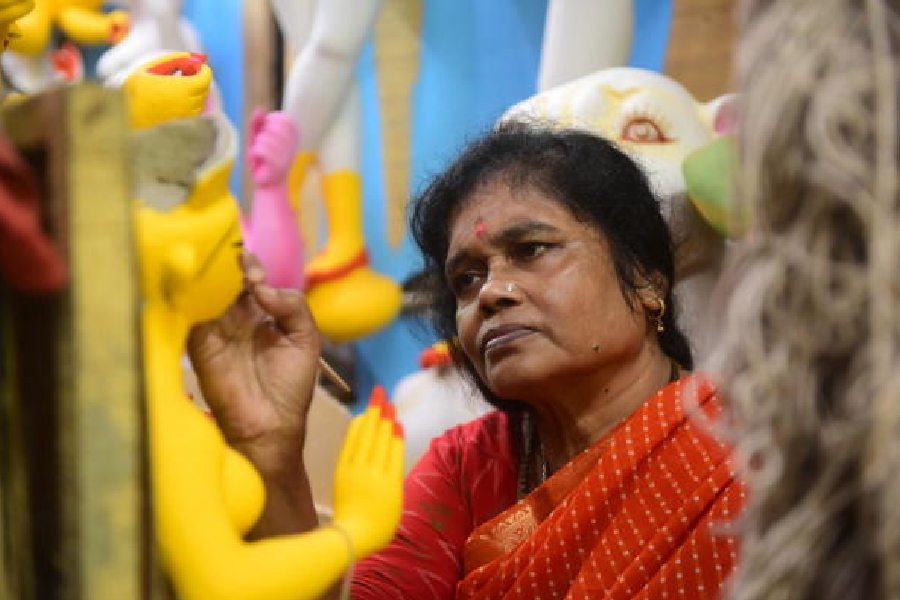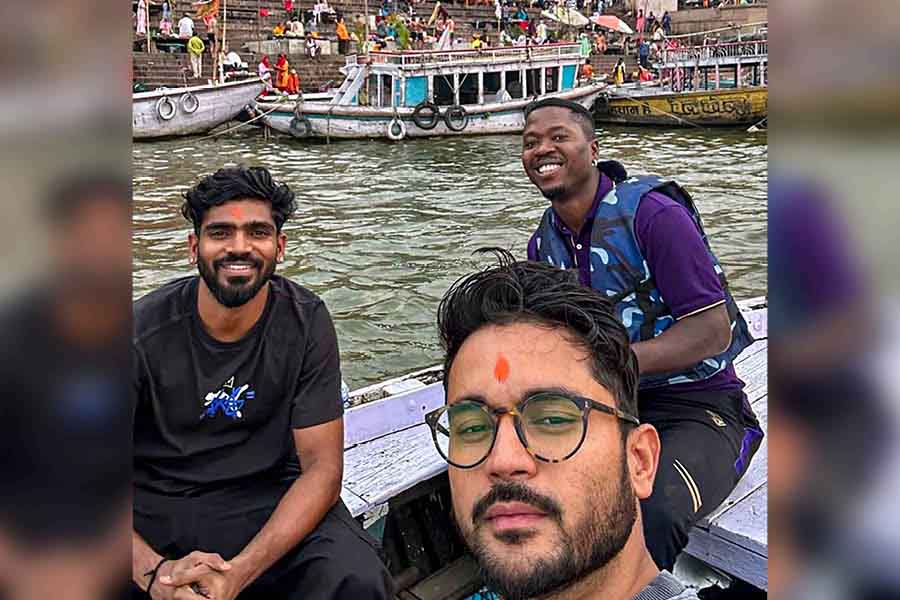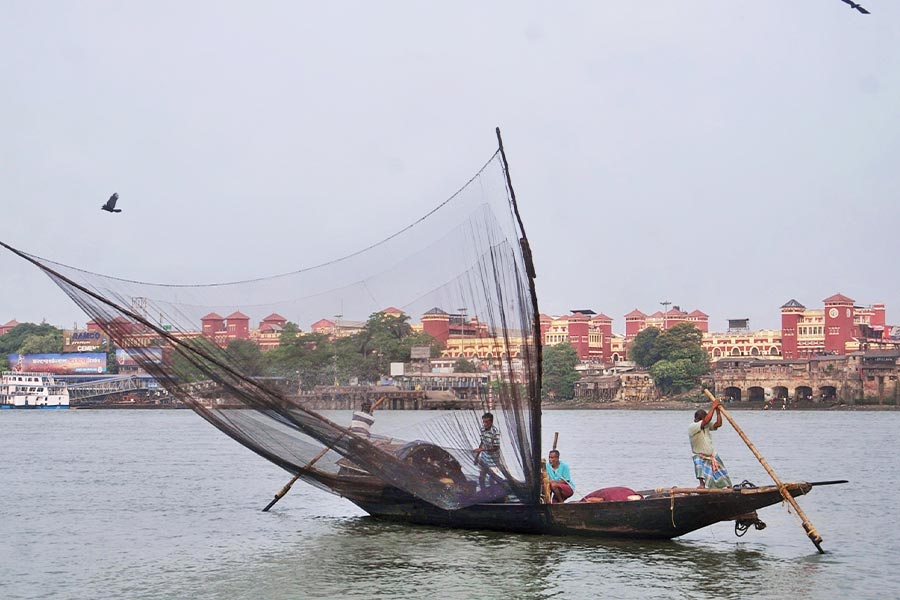The touristification of Kumartuli is complete. At its entrance stands a sturdy sign put up by the state tourism department that says “Tourist pick-up and drop point”.
Inside you get more confirmation. Even on the soggiest September evening, you have an army of camerapersons spreading out and taking up positions and you soon witness their targets: a stream of pretty young women wearing the most recognisable symbol of Bengali womanhood now: the lal-paar sari. They are also bejewelled and bewigged: their thick wavy jet-black false hair is cascading down their backs and the trishul flashes from some of their hands. They are mini goddesses; these are Puja fashion shoots and Kumartuli is the ideal backdrop for Insta.
Their parade makes the human Durgas almost as dramatic as the idols of the goddess that they stand against. Yet there can be no comparison: no human can measure up
to the figures that arise towering from the studio grounds, standing so closely and so numerously that their arms create a giant, surreal network of their own.
Atheist or believer, you know you are in the presence of something larger-than-life in Kumartuli, the birthplace of idols, of Ma Durga’s in particular. This something no camera eye can capture. In one of the studios not very far from the entrance sits China Pal. She is one of the pioneer woman idol-makers in Kumartuli. She, too, radiates presence. The 48-year-old sitting on the floor of the studio, barred by a bamboo
pole at the entrance to stop the invading cameras, looks almost as still as the
figures of the goddess she is surrounded by.
When she is not being frantic, that is. With only a few days remaining for Durga Puja, the idols need to be completed fast, and her days are crazy.
She is also a celebrity, partly because of her gender, because a woman idol-maker remains a rare person in Kumartuli. But she is also celebrated because her idols, all of them traditional, are stunning. In these days when religion is being used as a political weapon, her goddesses remind how religion is also the source of the most beautiful and powerful imagery. And that power is not necessarily aggression; it is strength, even gentleness. Durga in Bengal kills evil but is also a mother and a daughter. Pal has a distinct style, marked by the idols’ features, such as the delicate curves of the eyes of the idols, their betel-leaf shaped faces, the fine nose and the small, but perfect, bow-like lips.
Some of Pal’s Ganeshas are painted a vivid red, as one tradition insists, not the mainstream pink. Durga’s daughters, Lakshmi and Saraswati, often stand cross-legged and her other son, Kartik, sits astride his peacock, emphatically. But what makes Pal’s idols most outstanding is their grace.
“Please don’t mind, bit I can only give you 15 minutes now,” says Pal briskly at the first interview. “Like my father, I only make traditional ekchala idols,” she starts. “I have never made an ‘art’ idol.”
“Art” idols mean those made in experimental styles. Ekchala is the single, traditional, arched support that holds all the idols from the back together, creating an effect of unity for Durga’s family.
She inherited the studio from her father, Hemanta Kumar Pal, an idol-maker, because it was her passionate desire. “From the time I was a child I used to come here and watch the making of idols,” she says. “I was determined to be an idol-maker.” But girls had no easy entry here.
“My father had told me that it was not enough to own a studio. I had to learn the craft, every aspect of it,” she says. This she did from the artisans at the studio, all men. She at times dropped in when her father was not here, which made her feel more free.
“This is my home now,” she says, though she lives with her mother at a place nearby.
She lost her father when she was around 16. The youngest of six siblings, two sons and four daughters, she was determined to step in. That was not easy either.
Customers would move on to the next studio when a young girl came to take their order. But others at the studio helped her, reminding the customers that she was her father’s daughter.
“And I stayed on. From early morning, before eight, reporting time for all, till one in the afternoon, when I used to go home to eat, and come back at three. Then stayed on till late evening,” she says. “I used to help my mother with household work, too, but then she was well and looked after me and the household,” says Pal. Now her mother is old and infirm and Pal looks after her.
“I was always here,” she says again. Then she plunges into explaining the elaborate practice of preparing the soil. Several types are prepared and applied in layers.
“First we mix entel mati (clayey soil) with bele mati (sandy soil) for the idol’s face, which is everything. The proportion is very important. After entel mati is applied tush mati (clay mixed with rice husk). Then entel mati is mixed with tush mati to make ekmete mati and applied. Then is applied kholer mati, which is tush mati mixed with jute. The stronger soils hold the surface together from behind,” she says.
“You have to learn to get every mix right through trial and error,” she says. The surface of the entire idol is smoothened with bits cut from a soft handwoven cotton sari or dhoti, “with no buti”, says Pal. Buti is the woven polka dot; it would make the cloth rough. Mixing the different paints is another elaborate practice.
“Now I have to go,” says Pal. She has another studio nearby. She will not say how many idols are ordered this year. “I never say that. Let’s say it’s business as usual,” she smiles.
She rushes out with an assistant towards Rabindra Sarani and hails an autorickshaw. As she is getting in she asks me to call her at 10pm. “Another reason I like to make ekchala idols is that it keeps the family together, which is a rare sight these days,” is her parting shot as the autorickshaw disappears in the direction of the great river.
The three decades or so that she has been in her studio has earned her a place of distinction in Kumartuli. She has won many awards, has been the face of women’s empowerment on several platforms and has been interviewed and photographed endlessly, as she is being now, in the Puja season. Her idols have travelled widely, though she prefers to make them for local pujas, as she is most appreciated in the city, she says.
In 2018, she went to Kunming in China to attend an art festival. She seems to see these years as a blur of hectic activity, rather than as landmarks in her career. The here and the now is so demanding for her that she appears unable to look up from the immediate.
Accomplishment and honour do not always make things easier. When I call her at 10pm, she says she has not finished sandhya, the evening worship, or her cooking. When I call her again next evening, about the same time, she says she is yet to offer sandhya or finish her cooking, again, but will manage a few minutes. I can hear utensils being washed as she speaks. She is single.
She recalls one idol she made with pride.
In 2015, she was approached by a transgender community to make an “Ardhanariswar” idol, half Durga, half Shiva. Pal agreed readily. The organisers had not wanted a showpiece puja; they had wanted it to be a real one that was integrated with the larger community. So they collaborated with a north Kolkata club for the puja.
As work on the idol started — “I had also ordered a special half mukut (crown) for the Durga side from Krishnagar,” says Pal — murmurs of disapproval also started. A few days before the puja, the disapproval turned into outrage. How could such a community organise a Durga puja, the organisers were asked.
Thankfully, the idol began to receive a lot of attention in national and international media, which silenced its critics. The puja was performed according to all rituals and joyously.
The idol was exquisite. It was gorgeous. Its face was unique: its two sides were completely contrary. The eyes, the brows, the lips (one side had a moustache), even the nose and the third eye were different on the sides. The crown sat next to Shiva’s flowing matted hair. Yet nothing seemed out of place. The two sides formed one whole. This unity seemed close to perfection.
“Mone hoyechhilo kichhu korechhilam,” says Pal. “I had felt as if I had done something.”






